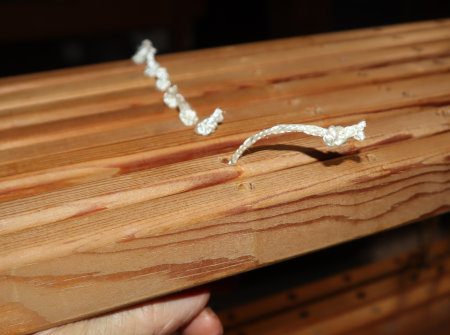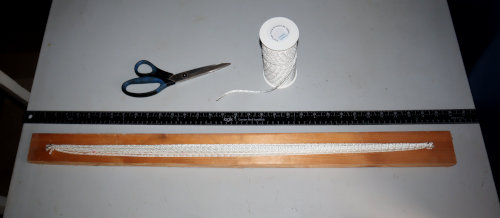Even though I understood the concept in my head, the particulars of the "from the top" tie-up (aka "Top O' the Lamm") were a bit puzzling at first. I have both Kati Meek's Complex Weaver's Journal article and Jean Elizabeth Studio blog post (see my resources post for details), but even though they were both using Glimakra Standard looms like mine, their measurements vary just a bit.
The first thing I did was to measure my loom from the floor to the top of the upper lamm.
 |
| 23 inches from the floor to the top of the upper lamm. |
The idea is to cut the Texsolv cords so that if a treadle is resting on the floor, there is still enough length above the top lamm to pin the cord as needed. Kati cut her cords at 25 inches, while Jean cut hers at 28.
The next step was figure out how much Texsolv cord I'll need. The cords will run from the bottom of the treadles, up through the lower lamm holes and then the upper lamm holes, with enough cord to secure each so that it doesn't slip back through. I have 10 treadles with 8 holes each (one for each shaft) so I'll need a total of 80 cords cut the same length.
If I go with the 25 inch length, I'll need 55.5 yards of Texsolv cord. I have a new, full spool which is 55 yards! Sheesh. But I also have a few yards left on an old spool, so I should be good to go there.
I'll also need 240 Texsolv pegs (pins).
 |
Texsolv "buttonhole" cord and anchor pins. They also make an
"arrow" pin, but these are the ones I have so that's what I'll use. |
I'll need one for each of the treadle holes, lower lamm holes, and upper lamm holes. After removing all of the old treadle cords, I find I have only 105! At $16 per 25 anchor pegs, I'm considering alternatives for at least some of them.
Jean used pony beads to secure the cord under the treadles (see her blog post for photos). If I do that I'll only need 160 anchor pegs. But also, I found a video on how to use push pins to make substitutes.
Texsolv Cord Pegs - Weaving Hack! Alternative to Pegs
Push pins are certainly less expensive, and there are a number of places I can substitute them.
After I get some pony beads and push pins, I'll be ready to get started.
Related post










